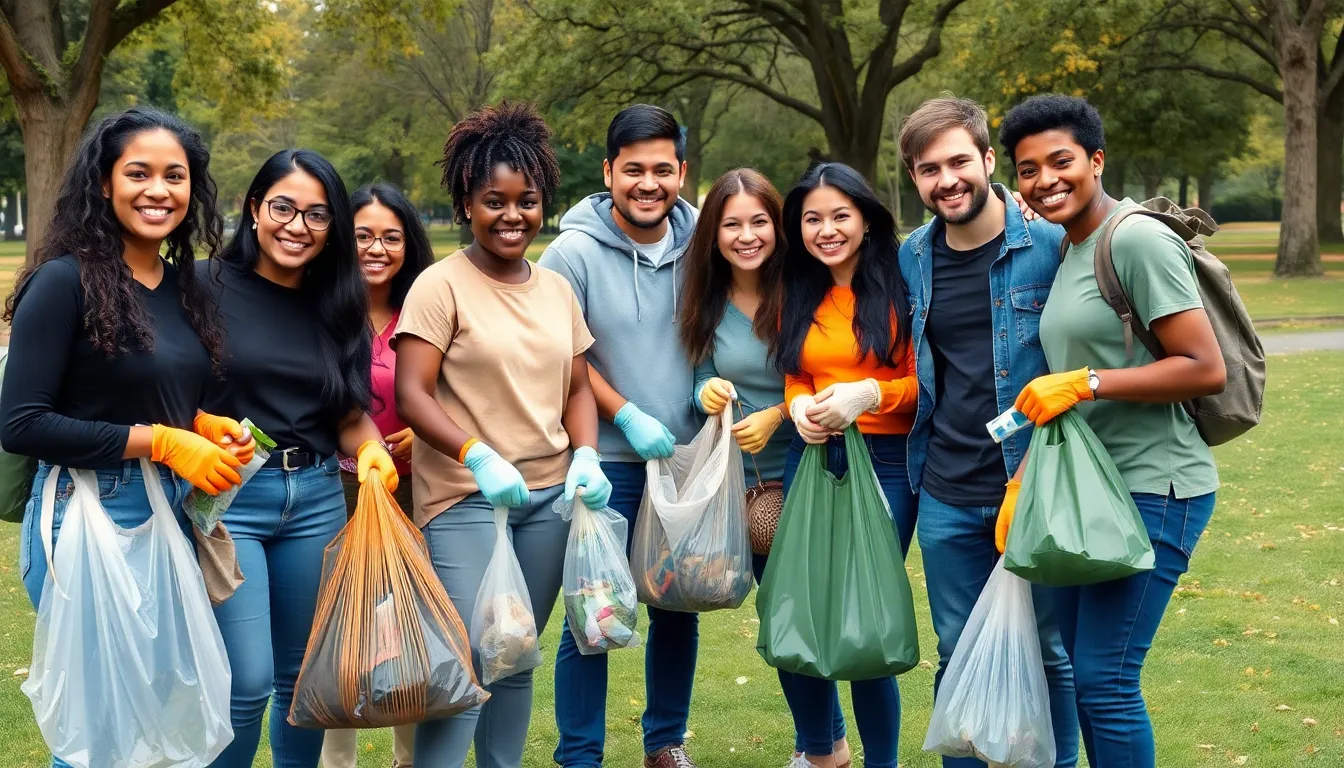Table of Contents
ToggleIn a world where plastic straws seem to multiply like rabbits and carbon footprints are the new fashion trend, sustainable living has never been more crucial. It’s not just about hugging trees or wearing hemp sandals; it’s about making smarter choices that benefit both the planet and your wallet. Imagine reducing waste while saving cash—sounds like a win-win, right?
Sustainable living isn’t just a buzzword; it’s a lifestyle that’s here to stay. From eco-friendly products to energy-efficient homes, there’s a treasure trove of options waiting to be explored. Embracing this lifestyle can feel like a superhero move, minus the cape. So buckle up, because diving into sustainable living might just be the most rewarding adventure yet, and who knows, you might even impress your friends with your newfound eco-savvy skills.
Understanding Sustainable Living
Sustainable living encompasses making choices that protect the environment while enhancing one’s quality of life. It promotes practices that reduce waste, conserve resources, and lead to a healthier planet.
Definition and Principles
Sustainable living refers to a lifestyle that aims to minimize an individual’s or society’s use of the Earth’s natural resources. Core principles include reducing energy consumption, utilizing renewable resources, and practicing waste reduction. Implementing eco-friendly practices such as recycling, composting, and using sustainable products informs daily choices. These actions collectively contribute to long-term environmental health and social equity.
Importance of Sustainable Living
Embracing sustainable living carries significant importance in addressing climate change and environmental degradation. Research shows that simple adjustments in daily habits can lead to substantial reductions in carbon footprints. Additionally, sustainable practices promote economic benefits through lower utility bills and long-lasting materials. By prioritizing this lifestyle, individuals not only enhance their well-being but also foster a sense of community and responsibility toward future generations. Adopting sustainable living principles creates a foundation for a more balanced and resilient ecosystem.
Daily Practices for Sustainable Living

Daily practices play a crucial role in achieving sustainable living, with two key areas being waste reduction and energy efficiency.
Reducing Waste
Reducing waste begins with mindful shopping choices. Consumers should prioritize reusable items, such as bags, bottles, and containers. Composting organic waste contributes to a healthier environment and minimizes landfill use. Participating in community recycling programs enhances resource recovery. Donations of unwanted items support those in need while decreasing overall waste. Understanding packaging labels encourages the selection of eco-friendly products. Engaging in community clean-up events actively fosters a cleaner local environment.
Energy Efficiency
Energy efficiency significantly cuts down on overall energy consumption. Individuals can implement simple changes like using LED bulbs, which consume up to 75% less energy than traditional bulbs. Setting thermostats to energy-efficient levels contributes to lower heating and cooling costs. Utilizing smart power strips restricts power drainage from electronics in standby mode. Homeowners may consider investing in energy-efficient appliances that conserve resources over time. Weatherization techniques, such as sealing drafts, improve insulation and lower energy demands. Investing in renewable energy sources, like solar panels, further enhances energy independence while reducing carbon footprints.
Sustainable Living in the Home
Sustainable living at home involves practical steps that reduce environmental impact while enhancing daily comfort. Integrating eco-friendly practices leads to a healthier lifestyle.
Eco-Friendly Products
Choosing eco-friendly products significantly reduces harmful waste. Items such as biodegradable cleaners, reusable shopping bags, and natural personal care products minimize toxicity. Preference for organic fabrics in bedding and clothing supports sustainable agriculture. Looking for certification labels like ENERGY STAR ensures energy efficiency in appliances. Investing in sustainable home goods not only protects the planet but also promotes a healthier living space.
Water Conservation Strategies
Adopting water conservation strategies proves essential for sustainable living. Installing low-flow faucets and showerheads decreases water usage without sacrificing comfort. Utilizing rain barrels captures rainwater for garden irrigation, providing an eco-friendly alternative. Regularly checking for leaks prevents water waste and lowers utility bills. Practicing simple habits like turning off the tap while brushing teeth conserves significant amounts of water daily. Each effort contributes to a more sustainable home environment.
Community and Sustainable Living
Community involvement plays a pivotal role in promoting sustainable living. Local initiatives foster a sense of belonging while addressing environmental concerns.
Local Initiatives
Community gardens enhance food security and encourage biodiversity. These gardens allow residents to grow their own produce, reducing reliance on store-bought items. Neighborhood clean-up events empower individuals to take action against litter and pollution. Recycling drives engage residents, promoting awareness of waste reduction. Furthermore, workshops on composting and sustainable practices share valuable knowledge among community members, fostering collective growth in environmental stewardship.
Supporting Sustainable Businesses
Shopping local supports small businesses while prioritizing sustainability. Sustainable businesses often focus on eco-friendly products and ethical sourcing. Choosing local vendors reduces carbon footprints associated with transportation. Farmers’ markets provide an excellent opportunity to access organic produce while supporting local agriculture. Community-supported agriculture (CSA) programs strengthen connections between consumers and farmers. These initiatives encourage patrons to invest in their local economies while promoting awareness about sustainable practices among business owners.
Challenges to Sustainable Living
Sustainable living faces various obstacles that hinder its growth. Understanding these challenges can help individuals and communities work toward more eco-friendly practices.
Common Misconceptions
Misunderstandings abound regarding sustainable living. Some think it requires a complete lifestyle overhaul, but small changes can lead to significant impacts. Others believe that sustainable products lack quality or affordability. In reality, numerous eco-friendly options combine durability with competitive pricing. Another frequent misconception is that sustainable living is solely about recycling. While recycling is essential, it represents just one aspect of a broader commitment to reducing waste and conserving resources.
Barriers to Adoption
Barriers to adopting sustainable practices include cost and convenience. Many people perceive eco-friendly products as more expensive. However, investing in sustainable items often results in long-term savings. Time constraints also impede individuals from prioritizing eco-conscious choices. In busy lives, it’s easy to overlook simple steps like meal planning or adopting energy-efficient appliances. Additionally, lack of awareness affects community engagement. Not everyone recognizes the benefits of local initiatives, which often leads to missed opportunities for collective growth and accountability.
Embracing sustainable living is a powerful step toward a healthier planet and a more fulfilling lifestyle. By making conscious choices and adopting eco-friendly practices individuals can significantly reduce their environmental impact while enjoying the benefits of lower costs and enhanced community connections.
Every small change contributes to a larger movement that fosters resilience and responsibility for future generations. As more people engage in sustainable practices the collective effort can lead to a profound transformation in how society interacts with the environment.
Ultimately the journey toward sustainability is not just about personal gain but about nurturing the planet for everyone.







